|
Green Man Garden Services
Landscaping • Clearance • Hedge Trimming • Lawn Cutting • General Maintainance • All Aspects of Tree Work
For a Free Consultation call 01978 856343 stephen.goodwin17@btinternet.com
Click on the Green Man to visit our website!
 |
Chester:
A
Virtual
Stroll
Around
the
Walls
Melkin's Prophecy IX
by Steve Goodwin
On to Chapter 10 | Bibliography | Back to Chapters 1 | 2 | 3 | 4 | 5 | 6 | 7 | 8

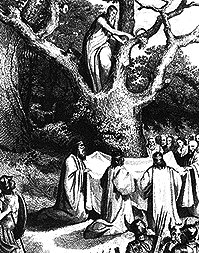 he area around Mold, Flintshire has a further tradition regarding a wattle church which will briefly discuss here. This tradition was first recorded by a chronicler from Gaul called Contantius of Lyon at the end of the 5th century in his account the life of Germanus of Auxerre. What is interesting is that Constantius’ account of Germanus is liberally scattered with place-names and the titles of characters, but suspiciously there is none of this detail with regarding to Germanus’ exploits in Britain. A thorough reading of the text suggests that the British element of the text has either been altered or at least distorted to suit the needs of its continental patron. However, some of the original story can still be discernable and may have an allegorical form.
he area around Mold, Flintshire has a further tradition regarding a wattle church which will briefly discuss here. This tradition was first recorded by a chronicler from Gaul called Contantius of Lyon at the end of the 5th century in his account the life of Germanus of Auxerre. What is interesting is that Constantius’ account of Germanus is liberally scattered with place-names and the titles of characters, but suspiciously there is none of this detail with regarding to Germanus’ exploits in Britain. A thorough reading of the text suggests that the British element of the text has either been altered or at least distorted to suit the needs of its continental patron. However, some of the original story can still be discernable and may have an allegorical form.
Germanus was sent to Britain by the Pope and the Bishops of Gaul to put down what was called the Pelegian Heresy early in the 5th century. This early account is written in the form of a hagiography which is essentially church propaganda praising the purity and righteousness of this important Catholic saint. Nevertheless, Constantius points out at the beginning of his account that he was elaborating an earlier account from an eye-witness, Lupus, who travelled to Britain with Germanus. Their mission was to put an end to a heresy that had sent shock waves from Britain to Egypt by undermining the authority of fragile Pauline-Roman Church which had not yet fully secured its grip through its dogmatic orthodoxy.
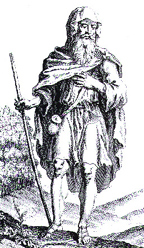 Pelagius was a British monk born around the mid 4th century and tradition states that he was educated at the Monastery of Bangor-on-Dee and travelled to Rome sometime before the end of the 4th century where initially he was held in high regard. He claimed along with his other British followers that it was possible to live with out sin. This was attained through an individual’s ability to exercise ‘free will’ and interaction with God on a personal level. These views where perceived as a threat to the emerging orthodoxy, which upheld the doctrine of ‘original sin’, and consequently, that people could only be saved by the hierarchy of the priesthood and through the grace of God. Literally, ‘Extra ecclesiam nulla salus’-‘outside the Church there is no salvation’. This view was championed by Augustine of Hippo (c.386-430 AD) who maintained that everything was pre-ordained and that man was polluted by the original sin of Adam. Furthermore, as God had pre-ordained everything man had no free will. Seeing the danger of Pelagius’ message Augustine pushed for his excommunication by portraying Pelagius as a mere monk and heretic. Essentially Pelagius’ position allowed man to by-pass the church structure and deal directly with the ‘divine’. This was dialectically opposed by Augustine who sanctioned a bastardised Pauline doctrine in which a select few were elected by God. For Augustine, the only mediator was the Church and its priests would deal with the sins of man. The stakes were very high and Pelagius and his followers were eventually denounced and sought refuge at Constantinople. At this point Pelagius vanishes from the historical records (c.420 AD), however, his message resonated for many centuries to come as his followers clashed with the Roman creed rejected its wealth, power and doctrine. The early Church had developed in a climate of persecution, due to this abuse, what developed was an intolerant and paranoid ministry which was to reveal it dark side repeatedly in centuries to come.
Pelagius was a British monk born around the mid 4th century and tradition states that he was educated at the Monastery of Bangor-on-Dee and travelled to Rome sometime before the end of the 4th century where initially he was held in high regard. He claimed along with his other British followers that it was possible to live with out sin. This was attained through an individual’s ability to exercise ‘free will’ and interaction with God on a personal level. These views where perceived as a threat to the emerging orthodoxy, which upheld the doctrine of ‘original sin’, and consequently, that people could only be saved by the hierarchy of the priesthood and through the grace of God. Literally, ‘Extra ecclesiam nulla salus’-‘outside the Church there is no salvation’. This view was championed by Augustine of Hippo (c.386-430 AD) who maintained that everything was pre-ordained and that man was polluted by the original sin of Adam. Furthermore, as God had pre-ordained everything man had no free will. Seeing the danger of Pelagius’ message Augustine pushed for his excommunication by portraying Pelagius as a mere monk and heretic. Essentially Pelagius’ position allowed man to by-pass the church structure and deal directly with the ‘divine’. This was dialectically opposed by Augustine who sanctioned a bastardised Pauline doctrine in which a select few were elected by God. For Augustine, the only mediator was the Church and its priests would deal with the sins of man. The stakes were very high and Pelagius and his followers were eventually denounced and sought refuge at Constantinople. At this point Pelagius vanishes from the historical records (c.420 AD), however, his message resonated for many centuries to come as his followers clashed with the Roman creed rejected its wealth, power and doctrine. The early Church had developed in a climate of persecution, due to this abuse, what developed was an intolerant and paranoid ministry which was to reveal it dark side repeatedly in centuries to come.
With Pelagius sidelined on the continent the Catholic Church had to route out the heresy at its source in Britain. In 429 AD, with backing from Rome, the Bishops of Gaul sent Germanus to combat the heretical British Church. The 5th century account states that after a series of miracles, Germanus managed to persuades some of the British clergy of their error. The interesting aspect is what was called the “Alleluia victory”. This was where Germanus took command of thousands of men at Easter, built a wattle church and lead them to victory over their enemy by instructing his men to “three times chanting Alleluia” in a valley surrounded by high hills. The subsequent echo sent the enemy into panic and the day was won by the great deeds of the saintly Germanus.
The exact location of this astonishing battle has been disputed for centuries. Some believe it took place in Kent due to its proximity to Gaul (France), however, the terrain doesn’t fit the account. For others, the battle took place in Yorkshire, but there is no local tradition to bolster the claim. I believe that this allegorical battle took place in the area around Mold, Flintshire. This belief is backed up by folklore and local tradition which places the building of the wattle church and the Alleluia victory firmly within this area. Some scholars argue that the battle could not have occurred here as the saint in question was a different Germanus/Garmon. However, another variant of Germanus’ expedition is recorded in documents known by the collective name of Nennius which were first put together in the 8th century. In this account Germanus comes to Britain and destroys the stronghold of a pagan king called Benli Gawr. 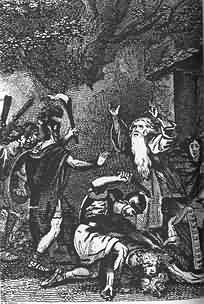 Again, the stronghold in question is located on the slopes of Clwydian mountain range, as Bartrum points out: “The district where Benlli evidently ruled is marked by a conical hill called Moel Fenlli.” (Bartrum:1993:p.40)
Again, the stronghold in question is located on the slopes of Clwydian mountain range, as Bartrum points out: “The district where Benlli evidently ruled is marked by a conical hill called Moel Fenlli.” (Bartrum:1993:p.40)
It is of interest that a so called tyrannical king is remembered in this mountain range and also as the Welsh name from the sacred island of Bardsey or Ynys Enlli. Furthermore, we are also informed that Benlli had a son called Beli, and local tradition and poetry places Beli’s grave on the hillside opposite Moel Benlli/Fenlli:
“There is a spot on the mountain between Ial and Ystrad Alun above Rhyd y Gyfarthfa, called Y Maes Mawr where occurred the battle between Meirion ap Tybion and Beli ap Benlli Gawr; and there Beli ap Benlli was slain. And Meirion erected two standing stones, one at each end of the grave. These were there up to the last forty years.” (Peniarth MS.267 p.26 [c.1635]
The grave of Beli is also identified in the “Stanzas of the Graves” in the Black Book of Carmarthen (c.1235):
Whose is the grave on Maes Mawr?
Proud with his hand on his sword,
the grave of Beli son of Benlli Gawr.
Maes Mawr or ‘the great field’ is on the high ground opposite the Moel Benlli/Fenlli at a place called ‘Nant y Meini’ or ‘the Brook of the Stones’. Is this the same Abbadare/Beli with a sword in his hand, which is the symbol of judgement/justice which in turn equates with ‘sapshat’ , and who was also a ruler of the Pagans which is the Latinised spelling of the Welsh word ‘Powys’?
- Abbadare/Beli’s burial mound is located on a hill above the market town of Mold or Yr Wyddgrug (the burial mound) opposite the Fort to Afallach (see map 10).
- The Black Book of Carmarthen (c.1235) states that the noble pagan Beli was buried holding his sword. D. Fontana’s (1993) The Secret Language of Symbols points out that; “In Christianity, Archangel Michael carries a sword symbolizing divine judgement” and this in turn equates with ‘saphat’ a cropped form of the biblical Josaphat which means God judgement which is symbolically the sword.
- The most noble of pagan gods is Beli who was symbolically a ‘sacred tree’ and a ‘noble worrior’.
- Monastery of Afallach.
- Market town of Mold/Yr Wyddgrug (The Mound of the Grave).
- Moel Fenlli (Hill of Benlli) where we find Llys Benlli (Benlli’s Court) where Germanus killed Benlli Gawr.
- Rhyd y Gyfarthfa (Ford of the Barking) connect the goddess to the king with future fertility.
- The burial mound of Beli who is called Abbadare in the ‘prophecy’ as both symbolise a ‘noble pagan warrior’.
We need to ask, why Germanus’ was sent to Britain? The answer as pointed out earlier was to put an end to the Pelagian heresy. Therefore, it would have been essential for Germanus to come to the North Wales area, as this was the centre of Pelagian thinking and where Pelagius himself was educated and where the 3 Perpetual Harmonies (Celtic Monasteries) were to be found. I have come to this conclusion due to the fact that what evidence there is fits into the landscape and traditions of this area and this again is echoed in the clues of Melkin’s Prophecy.
So if we recap on the prophecy so far:
more than all the world beside, for the entombment of then all,
is decorated beyond all others by the chanting sphere of prophecy.
And for all time to come adorned shall it be by them that praise the Most High.
Abbadare mighty in saphat, noblest of pagans, has fallen on sleep with 104000 others.
Among these Joseph of Arimathea hath found perpetual sleep in a marble tomb,
and he lies on a forked line next to the southern corner of an oratory,
where the wattle is prepared above the mighty maiden and where the 13 spheres rest.’
The whole of this section of the text is concerned primarily with geography. Furthermore, this corresponds with the geography of North East Wales in general and the site of Mynachlog or Monastery in particular. From this point on the prophecy deals with what is to be found at this site and the ramification of its discovery.
The prophecy continues: “For Joseph has with him in his sarcophagus 2 white and silver vessels, filled with the blood and sweat of the prophet Jesus.”
The Gospels state that following the crucifixion Joseph and Nicodemus prepared Jesus’ body for burial in the ‘manner of the Jews’ (John 19:40). Noel Currer-Briggs (1987) describes how it was customary at that time to wash the body, and then the body was rapped in clean linen and packed with herbs and spices, then the linen was bound to the body and coins were placed on the eyes. “Consequently there were at least six, and possibly seven pieces of cloth involved in a Jewish burial. Any one of these – apart, perhaps, from the outer bandages – could have been stained with sweat and blood.” (Currer-Briggs: 1987: p25)
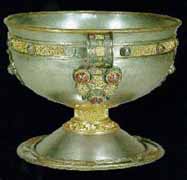 The Grail legend has traditionally been connected with the cup used by Jesus during the ‘Last Supper’, however, more recent speculation regarding the ‘true nature’ of the Grail has attempted to link it to the ‘Blood-line’ of Jesus and Mary Magdalene. ‘Melkin’s Prophecy’ offers an early independent tradition in which a ‘disciple’ of the ‘prophet Jesus’ held onto some the blood stained burial linen left after Jesus’ body disappeared from the tomb. Whether the disappearance of Jesus’ body was brought about by ‘divinely inspired resurrection’ or ‘human inspired plot’ depends on your personal perspective and religious orientation. Yet Joseph’s connection to the burial of Jesus is clear.
The Grail legend has traditionally been connected with the cup used by Jesus during the ‘Last Supper’, however, more recent speculation regarding the ‘true nature’ of the Grail has attempted to link it to the ‘Blood-line’ of Jesus and Mary Magdalene. ‘Melkin’s Prophecy’ offers an early independent tradition in which a ‘disciple’ of the ‘prophet Jesus’ held onto some the blood stained burial linen left after Jesus’ body disappeared from the tomb. Whether the disappearance of Jesus’ body was brought about by ‘divinely inspired resurrection’ or ‘human inspired plot’ depends on your personal perspective and religious orientation. Yet Joseph’s connection to the burial of Jesus is clear.
The earliest written gospel is Mark which scholars suggest was written some time around 70 AD. Both Luke and Matthew were written after this date using the same narrative form as Mark adding sayings attributed to the ‘living Jesus’ . John as we have it today was written later (c.115 AD), however, there is very strong evidence that John has at least two authors. The majority of the work was written by someone who calls himself ‘the Elder’ or ‘Presbyter’ who lived in Ephesus (Turkey) from c.100-150 AD. None of the authors of the four gospels ever met the ‘living Jesus’. In the 30-35 year difference between the crucifixion and the writing of Mark’s gospel the only Jesus literature that circulated was what scholars call the Gospel of Q. This was a list of 230 sayings of a Jewish Prophet called Yeshua (Jesus) with the emphasis on his life and not the death and resurrection. The death and resurrection element was later championed by St. Paul as the self appointed apostle to the Gentiles although he had never met the ‘living Jesus’. Interestingly, the original Gospel of Mark was altered by the early church fathers because it did not mention the resurrection. The gospel breaks off mid-sentence with Mary Magdalene running from the empty tomb and the last 12 verses of Mark 16 were added at later date for doctrinal reasons.
The Church went to great lengths to suppress the true nature of the man called Jesus as it clashed with their vision of the ‘Divine Christ’. However, in 1958 a lost letter was discovered from Bishop Clement of Alexandria (c.150-215 AD) to a colleague called Theodore. In the letter Clement states that parts of the original gospel of Mark should be suppressed as it didn’t conform to the teaching of the Church. He states:
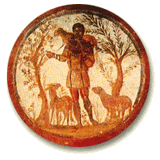 “For even if they should say something true,
“For even if they should say something true,
one who loves the Truth should not, even so,
agree with them. For not all true things are
the Truth; nor should that truth which seems
true according to human opinions be preferred
to the true Truth – that according to the faith…
For not all true things are to be said to all men.”
(St. Clement c.AD 150-215)
The so called ‘secret gospel’ of Mark, which was carefully guarded by the church of Alexandria, contains a version of the raising of Lazarus not found in the synoptic gospels.
It appears that the original version of Mark’s gospel needed to be amended due to the fact that by the time John’s gospel was conceived (c.115) Paul’s already radical view of ‘the Lord’ had evolved still further from its Jewish beginnings. This is significant as the Gospel of Mark was the first written and formed the structure for the other gospels. So the New Testament, as we have it, evolved from a Greek Pauline perspective which became dominant as gentile Christian began to out number Jewish Christian.
To 1st Century Jews, Jesus was either the awaited ‘Messiah/Prophet’ or a ‘False Prophet who lead Gods people astray’. This is clear from Jewish polemic writing regarding Jesus and early traditions that existed before the narrative Gospels were conceived. These were oral traditions in which Jesus is again portrayed as a prophet. The same view is also dominant in the Gnostic Gospel of Thomas, which many scholars argue pre-dates the New Testament Gospels, where the message of Jesus is conveyed as a series of 114 sayings attributed to the ‘living Jesus’. One of Britain’s most eminent New Testament scholars, Graham Stanton (1995), argues that the Gnostic reader of Thomas saw Jesus as; “a first-century Jewish prophet”. And, “ for the reader of Thomas, it is the esoteric, timeless words of the living Jesus, not the death and resurrection, which are the key to salvation”. (Stanton:1995:p.88)
On to part X
Site Front Door | Site Index | Chester:
A Virtual Stroll Around the Walls
The Black & White Picture Place | Readers Letters | Links
![]()


 he area around Mold, Flintshire has a further tradition regarding a wattle church which will briefly discuss here. This tradition was first recorded by a chronicler from Gaul called Contantius of Lyon at the end of the 5th century in his account the life of Germanus of Auxerre. What is interesting is that Constantius’ account of Germanus is liberally scattered with place-names and the titles of characters, but suspiciously there is none of this detail with regarding to Germanus’ exploits in Britain. A thorough reading of the text suggests that the British element of the text has either been altered or at least distorted to suit the needs of its continental patron. However, some of the original story can still be discernable and may have an allegorical form.
he area around Mold, Flintshire has a further tradition regarding a wattle church which will briefly discuss here. This tradition was first recorded by a chronicler from Gaul called Contantius of Lyon at the end of the 5th century in his account the life of Germanus of Auxerre. What is interesting is that Constantius’ account of Germanus is liberally scattered with place-names and the titles of characters, but suspiciously there is none of this detail with regarding to Germanus’ exploits in Britain. A thorough reading of the text suggests that the British element of the text has either been altered or at least distorted to suit the needs of its continental patron. However, some of the original story can still be discernable and may have an allegorical form. Pelagius was a British monk born around the mid 4th century and tradition states that he was educated at the Monastery of Bangor-on-Dee and travelled to Rome sometime before the end of the 4th century where initially he was held in high regard. He claimed along with his other British followers that it was possible to live with out sin. This was attained through an individual’s ability to exercise ‘free will’ and interaction with God on a personal level. These views where perceived as a threat to the emerging orthodoxy, which upheld the doctrine of ‘original sin’, and consequently, that people could only be saved by the hierarchy of the priesthood and through the grace of God. Literally, ‘Extra ecclesiam nulla salus’-‘outside the Church there is no salvation’. This view was championed by Augustine of Hippo (c.386-430 AD) who maintained that everything was pre-ordained and that man was polluted by the original sin of Adam. Furthermore, as God had pre-ordained everything man had no free will. Seeing the danger of Pelagius’ message Augustine pushed for his excommunication by portraying Pelagius as a mere monk and heretic. Essentially Pelagius’ position allowed man to by-pass the church structure and deal directly with the ‘divine’. This was dialectically opposed by Augustine who sanctioned a bastardised Pauline doctrine in which a select few were elected by God. For Augustine, the only mediator was the Church and its priests would deal with the sins of man. The stakes were very high and Pelagius and his followers were eventually denounced and sought refuge at Constantinople. At this point Pelagius vanishes from the historical records (c.420 AD), however, his message resonated for many centuries to come as his followers clashed with the Roman creed rejected its wealth, power and doctrine. The early Church had developed in a climate of persecution, due to this abuse, what developed was an intolerant and paranoid ministry which was to reveal it dark side repeatedly in centuries to come.
Pelagius was a British monk born around the mid 4th century and tradition states that he was educated at the Monastery of Bangor-on-Dee and travelled to Rome sometime before the end of the 4th century where initially he was held in high regard. He claimed along with his other British followers that it was possible to live with out sin. This was attained through an individual’s ability to exercise ‘free will’ and interaction with God on a personal level. These views where perceived as a threat to the emerging orthodoxy, which upheld the doctrine of ‘original sin’, and consequently, that people could only be saved by the hierarchy of the priesthood and through the grace of God. Literally, ‘Extra ecclesiam nulla salus’-‘outside the Church there is no salvation’. This view was championed by Augustine of Hippo (c.386-430 AD) who maintained that everything was pre-ordained and that man was polluted by the original sin of Adam. Furthermore, as God had pre-ordained everything man had no free will. Seeing the danger of Pelagius’ message Augustine pushed for his excommunication by portraying Pelagius as a mere monk and heretic. Essentially Pelagius’ position allowed man to by-pass the church structure and deal directly with the ‘divine’. This was dialectically opposed by Augustine who sanctioned a bastardised Pauline doctrine in which a select few were elected by God. For Augustine, the only mediator was the Church and its priests would deal with the sins of man. The stakes were very high and Pelagius and his followers were eventually denounced and sought refuge at Constantinople. At this point Pelagius vanishes from the historical records (c.420 AD), however, his message resonated for many centuries to come as his followers clashed with the Roman creed rejected its wealth, power and doctrine. The early Church had developed in a climate of persecution, due to this abuse, what developed was an intolerant and paranoid ministry which was to reveal it dark side repeatedly in centuries to come.  Again, the stronghold in question is located on the slopes of Clwydian mountain range, as Bartrum points out: “The district where Benlli evidently ruled is marked by a conical hill called Moel Fenlli.” (Bartrum:1993:p.40)
Again, the stronghold in question is located on the slopes of Clwydian mountain range, as Bartrum points out: “The district where Benlli evidently ruled is marked by a conical hill called Moel Fenlli.” (Bartrum:1993:p.40)  The Grail legend has traditionally been connected with the cup used by Jesus during the ‘Last Supper’, however, more recent speculation regarding the ‘true nature’ of the Grail has attempted to link it to the ‘Blood-line’ of Jesus and Mary Magdalene. ‘Melkin’s Prophecy’ offers an early independent tradition in which a ‘disciple’ of the ‘prophet Jesus’ held onto some the blood stained burial linen left after Jesus’ body disappeared from the tomb. Whether the disappearance of Jesus’ body was brought about by ‘divinely inspired resurrection’ or ‘human inspired plot’ depends on your personal perspective and religious orientation. Yet Joseph’s connection to the burial of Jesus is clear.
The Grail legend has traditionally been connected with the cup used by Jesus during the ‘Last Supper’, however, more recent speculation regarding the ‘true nature’ of the Grail has attempted to link it to the ‘Blood-line’ of Jesus and Mary Magdalene. ‘Melkin’s Prophecy’ offers an early independent tradition in which a ‘disciple’ of the ‘prophet Jesus’ held onto some the blood stained burial linen left after Jesus’ body disappeared from the tomb. Whether the disappearance of Jesus’ body was brought about by ‘divinely inspired resurrection’ or ‘human inspired plot’ depends on your personal perspective and religious orientation. Yet Joseph’s connection to the burial of Jesus is clear.  “For even if they should say something true,
“For even if they should say something true,